How to create an Ethernet crossover cable
Ethernet cables have been considered standard in network settings for years. It is the fastest way to connect PCs to a router or hub adapter. Sure, you can use a wireless connection for more convenience, but the fact that wireless connectivity will always be slower, and especially susceptible to interference.
Today's article will describe how to press the Ethernet crossover network. Let's find out soon!
How to create an Ethernet crossover cable
- What is a crossover cable?
- Why can you not need to use crossover cable?
- What do you need to create Ethernet crossover cables?
- How to create a crossover cable
What is a crossover cable?
In an Ethernet network environment - like in a home with many wired computers - all computers must connect to a central router. The router will take all the bits sent from computers and transfer them to other devices on the network, or to an external network. However, a crossover cable can be used to connect two devices directly, without the need for a router in the middle.
It simply reverses some of the pins, so that the output on one computer is sent to the input of another computer. Some people may have memories of using a crossover cable to play multiplayer games, before the Internet became popular.
Connecting two machines is a use of crossover cables. Another advantage is to extend the network by connecting another network adapter, thereby giving you more ports.
Why can you not need to use crossover cable?
After being explained how to use crossover cables, you should know that you may not need to use crossover cables. Most network devices are currently equipped with convertible ports called "autosensing" or "uplink". This is one of two software used to automatically detect when a port will be running in cross mode, or give you a physical switch, which you can use to activate this mode. They make cross-operation pins in the hardware switch itself.
In fact, you really only need a crossover cable if you are dealing with very old hardware (such as a hub), or if you want to quickly connect two computers in a network-free environment.
Even then, nearly all modern hardware will automatically detect what you are trying to do, and configure the Ethernet port appropriately without a crossover cable.
What do you need to create Ethernet crossover cables?
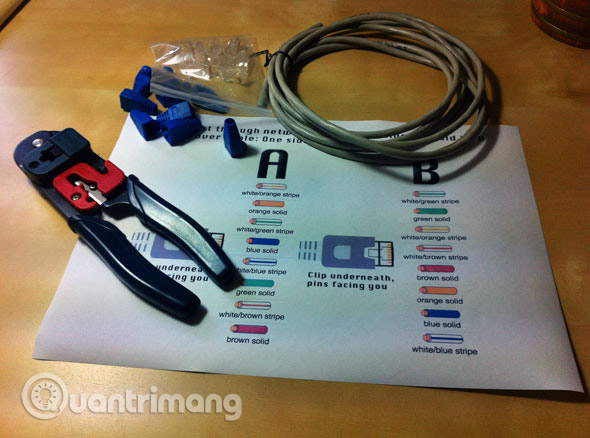
- An Ethernet cable (Sure enough): The article will use CAT5. Seriously, CAT5 is certified with true gigabit support, but in fact, older CAT5 cables are better used in short distances.
- A crimping tool: This 'all-in-one' tool is specially shaped to push the pins into the plug and can remove the protection cables, as well as cutting.
- 2 RJ45 plugs.
- 2 shield plugs (Optional).
The crossover cable is just a normal network cable but connects the transmitter pair of this computer to the receiving pair of the other computer and vice versa, so it can allow two computers to communicate with each other.
So what's different about this cable is not about the material, the wire or the connector, it's just an ordinary twisted cable with the inner wires of the connected connector slightly different on the other end. . You can buy this cable that has been prefixed or made by yourself if you have good manipulation skills.
In Figure 1, you can see how a crossover cable is. The cable itself is just a normal twisted-pair network cable. The color here doesn't matter.
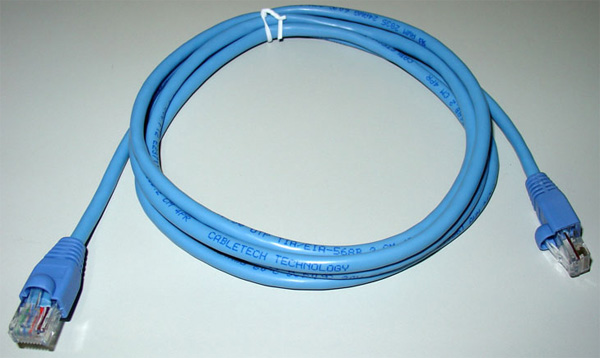
Figure 1: Crossover cable
The trick lies in one of the connectors. If you compare both connectors, you will see that the order of the pairs at the top is completely different from the order of the other end (each wire has its own color). On a pin-to-battery cable, both connectors use the same wire order.

Figure 2: The order of the different wires, that instruction is the crossover cable
(You can compare the position of the strings that orange and blue)
In addition to the above tools, you will also need a diagram to click the network, it is best to print out for easy monitoring. Note that parts A and B are not simply reversing each other:
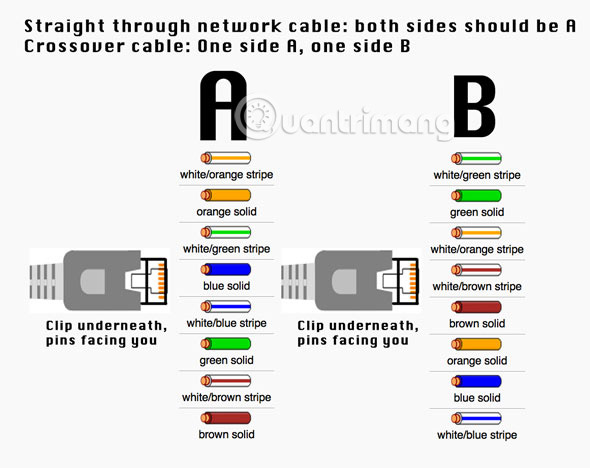
To help you make a cable yourself, we will introduce the order of the wires in the table below.
First order A Wire color First order B 1 White with green stripe 3 2 Green 6 3 White with orange stripe 1 4 Blue 4 5 White with blue stripe 5 6 Cam 2 7 White with 7 8 Brown stripes 8The table above is for 100Mbps networks. If you want to design a Gigabit Ethernet (1000BaseT) crossover cable, you need to follow the order shown in the table below (you also need to use Cat5e cable). This is because Gigabit Ethernet uses two pairs to transmit data and two pairs receive data.
First order A Wire color First order B 1 White with green stripe 3 2 Green 6 3 White with orange stripe 1 4 Blue 7 5 White with blue stripe 8 6 Cam 2 7 White with brown stripe 4 8 Brown 5How to create a detailed crossover cable
Start by screwing some shields into the cable. It will be easier to do this now.
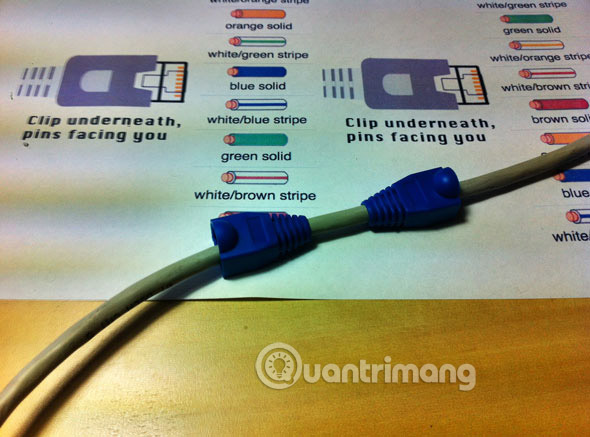
Cut off the cable cover at both ends, each end about 1.5cm with the tool mentioned above.
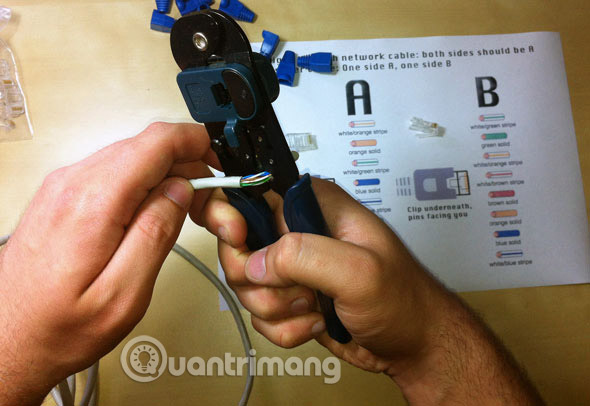
Remove the wires (note that there must be 4 "twisted pairs"). Arrange them in the order shown on the diagram, from top to bottom, one end to A, one end to B.
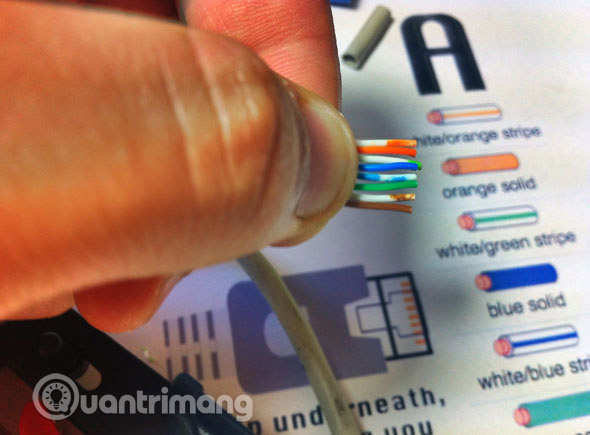
Once you have correctly identified the strings as in the diagram, group them together in a row. If the strings are short and irregular, fix it a bit so that they are of equal length.
The hardest part is putting them on the RJ45 plug without disturbing the order. Hold the plug with the clamp face facing out; The gold pins must be facing towards you, as shown below.
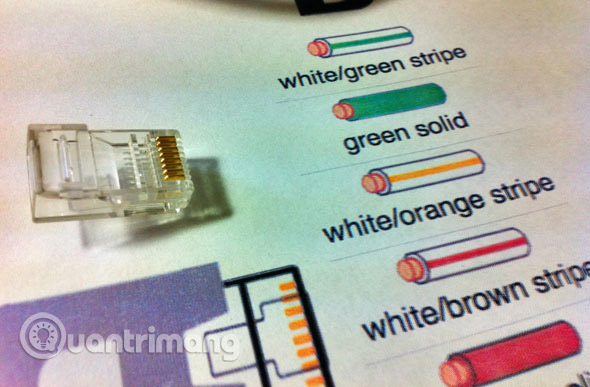
Push the cable in the right direction. The cable should be just as long as the slot at the end of the plug. Cut back the cables if necessary.
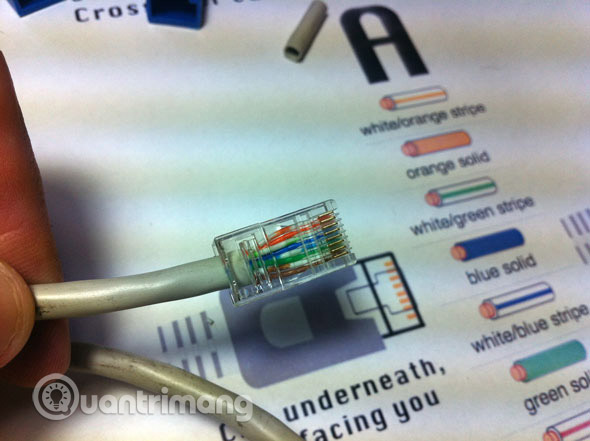
When the cables are firmly attached to the plug, plug it into the crimping tool and press down.
Do the same with the other end, using the B diagram instead.
If you do not have a cable test device, the easiest way to check is to plug in the device. Try connecting two computers directly to each other. The status LED changes with the device, but normally an LED will show up, while the other indicator indicates the speed.
Good luck!
See more:
- Build a network crossover cable
- Press cross cable for 1 Gigabit network card - EASY or DIFFICULT?
- Comprehensive guide for home networking
You should read it
- What is the maximum Ethernet cable length to not lose signal?
- Build a network crossover cable
- How to Protect an Outdoor Ethernet Cable
- Power over Ethernet cable
- How to Connect Two Computers Together Using a Network Cable
- What is CAT 6 network cable and how is it different from the CAT 5e network cable?
- Distinguish common types of computer cables
- These are the types of printer cables needed to connect to the computer
May be interested
- Distinguish common network cables
 electromagnetic shielding / screening is made of a sheet of metal / polyester or metal wire, surrounded by individual pairs of wires or all wires. this article will help you differentiate some types of ethernet cables.
electromagnetic shielding / screening is made of a sheet of metal / polyester or metal wire, surrounded by individual pairs of wires or all wires. this article will help you differentiate some types of ethernet cables. - How to Connect Two Computers Together with an Ethernet Cable
 this wikihow teaches you how to connect to computers to one another by using an ethernet cable. once you've connected the computers, you can share files between them by using both computers' file sharing settings. determine whether or not...
this wikihow teaches you how to connect to computers to one another by using an ethernet cable. once you've connected the computers, you can share files between them by using both computers' file sharing settings. determine whether or not... - Why is switching Smart TV to Ethernet so much better?
 many people thought streaming over wi-fi on their tv was fine, but decided to try ethernet because they had cable lying around. it improved things immediately, and now they wish they had made the switch.
many people thought streaming over wi-fi on their tv was fine, but decided to try ethernet because they had cable lying around. it improved things immediately, and now they wish they had made the switch. - How to Set Up a Wired Network (Ethernet)
 today's tipsmake will show you how to connect your computer directly to a router via ethernet cable, as well as how to set up ethernet settings on windows and mac computers.
today's tipsmake will show you how to connect your computer directly to a router via ethernet cable, as well as how to set up ethernet settings on windows and mac computers. - These are the types of printer cables needed to connect to the computer
 if the printer does not turn on wi-fi, you need to connect them using a cable. maybe your printer is second-hand and it doesn't have a cable or you may have lost it and don't know which cable your printer needs. so this article will introduce you to the most common cables used to connect printers to computers. please choose the most suitable printer connection cable.
if the printer does not turn on wi-fi, you need to connect them using a cable. maybe your printer is second-hand and it doesn't have a cable or you may have lost it and don't know which cable your printer needs. so this article will introduce you to the most common cables used to connect printers to computers. please choose the most suitable printer connection cable. - How to Connect a PC to a Mac
 although the two machines have different operating systems, you can still connect a windows pc and mac to each other and share files. you don't need any expensive equipment. all you need is an ethernet cable. get an ethernet/lan cable.
although the two machines have different operating systems, you can still connect a windows pc and mac to each other and share files. you don't need any expensive equipment. all you need is an ethernet cable. get an ethernet/lan cable. - Difference between Ethernet and LAN
 ethernet and lan are closely related, in that ethernet is the main technology that makes the concept of lan become reality. the main difference between ethernet and lan is that the operation of ethernet is decentralized, while lan is the opposite.
ethernet and lan are closely related, in that ethernet is the main technology that makes the concept of lan become reality. the main difference between ethernet and lan is that the operation of ethernet is decentralized, while lan is the opposite. - How to Hook up a Crossover
 a crossover is an audio signal processing unit that separates a single stereo audio signal into two, three, or sometimes even four frequency ranges. at a minimum, a crossover ensures that the high-frequency signal (i.e. the treble) goes...
a crossover is an audio signal processing unit that separates a single stereo audio signal into two, three, or sometimes even four frequency ranges. at a minimum, a crossover ensures that the high-frequency signal (i.e. the treble) goes... - Full latest Arise Crossover giftcode and how to redeem code for rewards
 with arise crossover giftcode, getting tickets along with other rewards will be much easier.
with arise crossover giftcode, getting tickets along with other rewards will be much easier. - How is wired (Ethernet) better than wireless (Wi-Fi)?
 wi-fi is obviously much more convenient than a wired ethernet connection. but why so far, ethernet is still the first choice for organizations, businesses and even individual users?
wi-fi is obviously much more convenient than a wired ethernet connection. but why so far, ethernet is still the first choice for organizations, businesses and even individual users?










 Things to know before installing a wired security camera system
Things to know before installing a wired security camera system Fix hard drive error still spinning but not receiving
Fix hard drive error still spinning but not receiving What to do when the computer does not accept the keyboard and mouse
What to do when the computer does not accept the keyboard and mouse How to check hard drive status with SMART
How to check hard drive status with SMART 7 best external hard drives
7 best external hard drives What is the best way to store and preserve laptop batteries?
What is the best way to store and preserve laptop batteries?